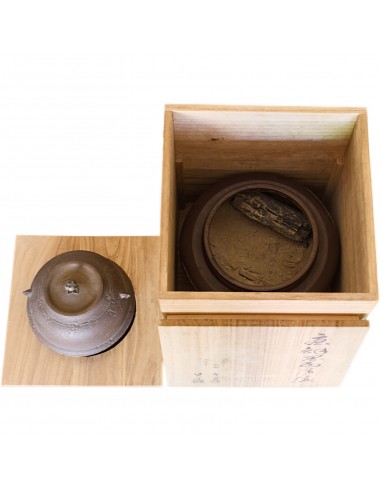Furo Windofen für Teezeremonie
Antique Japanese brazier (jp. furo) with matching iron tea kettle (jp. furogama) and wooden box for storage. Traditionally used for the tea ceremony. The coal fire basin has a bulbous shape with three short legs and two openings. Through the openings, the coal can be placed and the embers regulated. On the upper edge is the coal fire kettle (jp. kama), in which the water is brought to the boil during the tea ceremony. The kettle is dome-shaped, with two eyelets on the side. Lid with a round knob for lifting. Typical design of the Edo period (1603-1868). Clear signs of use, but in good, robust condition.
The tea ceremony, known as chanoyu or sadō in Japanese, is the ceremonial preparation and presentation of Matcha. It originated in the 12th century with the beginning of green tea cultivation in Japan, and was initially practiced by Buddhist monks. In the 16th century it was perfected by Sen no Rikyū as a stylized art form for which specially designed tea rooms (chashitsu) were built. An integral part of the ceremony is the charcoal-fired brazier, called furo in Japanese, on which the tea kettle (furogama) stands and in which the water for the green tea is heated. The sound of the water boiling in the kettle and the sight of rising steam add to the meditative atmosphere. Traditionally, the coal brazier is used during the warm months of May through October. In winter, the sunken fireplace ro is used. During the Edo period (1603-1868), the production of iron brazier reached its peak. The bulbous shape with three legs and two openings was characteristic of this period. The braziers were usually passed down from generation to generation. In their simple elegance and functionality, the furo reflect the essence of a specific Japanese aesthetic.
















